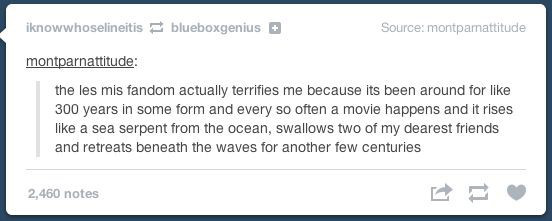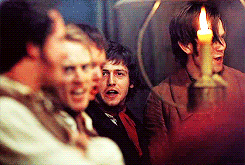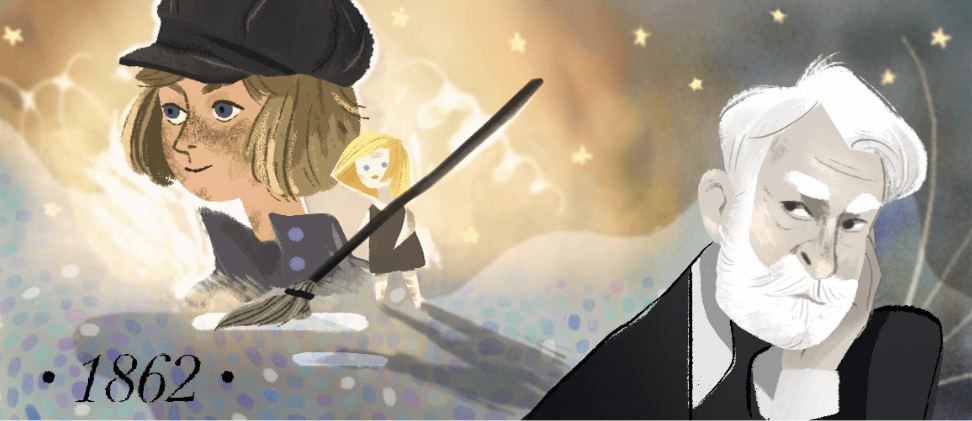On June 30, 1862, the final chapter of Victor Hugo’s timeless classic Les Misérables was published. “Timeless classic” is an adage often tossed around, but in this case, it could not be more spot-on. Les Misérables remains as relevant as it was upon publication, and if you read it it will change you as a person.
Yes, you will be irrevocably altered by exposure to Hugo’s epic, even if you hate it (lugging that much weight around makes it impossible to forget—there’s a reason that fans fondly refer to it as The Brick). But in all seriousness, Les Misérables is an important, upsetting, beautiful and moving read. It remains as Hugo’s most famous work—and Hugo had a prodigious output, including novels like The Hunchback of Notre Dame, poems, and plays now mostly forgotten—and it has carved a permanent place in popular culture.
The book has never fallen out of style since its emergence (it was a sensational best-seller in its day, though somewhat coolly reviewed by snooty critics). The reviews didn’t matter: Les Misérables was written for the people and the people embraced it. Generations of readers have continued to find its central themes of redemption, love, oppression, and agitation against unjust governments relatable. The 1980’s musical adaptation by Claude-Michel Schönberg and Alain Boublil became an international smash, and even non-musical folks are familiar with the show’s breakout songs like “I Dreamed A Dream” and “Do You Hear The People Sing?”
I’m a huge fan of the musical (I’m listening to it as I type this), and have been since childhood. If you want to go sing “One Day More!” with me at karaoke, I am forever ready. But it wasn’t until after college that I got around to reading Les Misérables in its entirety. It’s a prodigious undertaking: the book clocks in at over 650,000 words, making it one of the longest novels ever written.
This length ensures that even if you aren’t into some part of the story—the meandering intro to the Bishop of Digne, say—in its dozens of fascinating characters and decades-spanning plot, Les Misérables has something for everyone. How many books can you buy for a summer beach read and be certain of it sustaining you through winter?
Because of the ubiquitousness of the musical and movie adaptations (most recently Tom Hooper’s 2012 film, which won Anne Hathaway an Oscar in her role as Fantine, and starred Wolverine as Jean Valjean), many know the basic outline of Les Misérables:
Jean Valjean, branded a criminal for life for the crime of stealing a loaf of bread, pursued with dogged ferocity for decades by the unyielding police inspector Javert. Valjean’s salvation via the kindliness of a Bishop and the adoption of a young girl, Cosette, left in wretched circumstances by an unfortunate mother who sacrificed everything for her.
Much later there is Cosette’s love story with Marius Pontmercy, perhaps the original hipster (Marius exiled himself from his wealthy background for the love of his father’s Bonapartist politics and lived in near-poverty as a translator, spending most of the book basically yelling “I do what I want, Baron Grandpa!” when not making calf-eyes at Cosette).
Even later in the voluminous volumes a subplot is introduced concerning Marius’ friends, a group that calls themselves Les Amis de l’ABC (roughly “the friends of the people,” in a French word game such as Hugo delights in), led by the revolutionary firebrand Enjolras. Young, idealistic, and primarily children of privilege, these students band together to try and bring down the government—an ultimately toothless and wrenching protest to the harsh conditions the poor were laboring under.
It is difficult to find a writer as lauded as Hugo who took up the cause of the maligned with as much sympathy and grace. It might look neater in French, but we must remember that the book’s title translates into English as “The Miserable,” and it was this population that Hugo tried to lift up through his works and deeds. Dickens could come close, but we know how he felt about violent, class-shaking revolutions—they were the worst of times.
While often confused with the earlier French Revolution, the insurgent events depicted in Les Misérables are the June Rebellion of 1832, a brief and failed attempt to overturn the monarchy that was harshly put down by the National Guard. The tragic barricades so dramatically shown in the musical and in the book’s pages sprung up around the Paris that Victor Hugo witnessed first-hand.
Hugo, at age 30, was caught out in the streets during the uprising, and it made quite the impression: he labored for twenty years to write the story of Les Misérables and so gave a relatively minor political agitation a prominent place in history and memory. If you can read of these promising youths cut down in their prime with cries of “Long live the future!” without being moved, you have the staunch constitution of Javert.
Beyond its encompassing of days gone by, Les Misérables is a truly human and humane story, and this is what has kept it so recognizable to so many generations. The plight of women, the treatment of the underclasses, the cruelty of authority and the heavy hand of unjust law—these issues are, unfortunately, still universal. In a letter to the Italian translator of the book in 1862, Hugo wrote:
You are right, sir, when you tell me that Les Misérables is written for all nations. I do not know whether it will be read by all, but I wrote it for all. It is addressed to England as well as to Spain, to Italy as well as to France, to Germany as well as to Ireland, to Republics which have slaves as well as to Empires which have serfs.
Social problems overstep frontiers. The sores of the human race, those great sores which cover the globe, do not halt at the red or blue lines traced upon the map. In every place where man is ignorant and despairing, in every place where woman is sold for bread, wherever the child suffers for lack of the book which should instruct him and of the hearth which should warm him, the book of Les Misérables knocks at the door and says: “Open to me, I come for you.”
Les Misérables certainly isn’t light reading, though Hugo is also a highly skilled humorist who never saw a pun he did not like. There are passages of great levity, and, I would argue, the most profound sketches of the varied shades of humanity that you will encounter.
Take as an example what happens to Javert, who throughout the book has been Valjean’s primary antagonist, a man so steeped in the rigidity of his principles that it is inconceivable to him that certain laws could be unfounded and that a person once ruled to be a criminal could also be good. Javert may as well be a modern representative of everything still wrong in law enforcement and the criminal justice system and many people’s unwillingness to take our own systems to task when they help sustain inequality.
But upon finally accepting that Valjean is not what he believed him to be, Javert suffers a complete breakdown of self in some of the more spectacular passages of text I have ever encountered. He ends up penning a letter about all the injustice he has witnessed and taken part in before taking his own life, unable to grapple with a world much more complicated than he had let himself see. To read along with Javert is to experience the mental cartwheels that he does. I think about Javert’s revelation all the time, and wish I could make it requisite reading.
Or, for another and nearly opposite view of the human condition, gaze upon Hugo’s description of the cynical, alcoholic Grantaire, attached to the revolutionary Friends of l’ABC only by the force of his affection:
Among all these glowing hearts and thoroughly convinced minds, there was one sceptic. How came he there? By juxtaposition. This sceptic’s name was Grantaire, and he was in the habit of signing himself with this rebus: R. Grantaire was a man who took good care not to believe in anything. […]
All those words: rights of the people, rights of man, the social contract, the French Revolution, the Republic, democracy, humanity, civilization, religion, progress, came very near to signifying nothing whatever to Grantaire. He smiled at them. Scepticism, that caries of the intelligence, had not left him a single whole idea. He lived with irony. This was his axiom: “There is but one certainty, my full glass.” […]
However, this sceptic had one fanaticism. This fanaticism was neither a dogma, nor an idea, nor an art, nor a science; it was a man: Enjolras. Grantaire admired, loved, and venerated Enjolras. To whom did this anarchical scoffer unite himself in this phalanx of absolute minds? To the most absolute. In what manner had Enjolras subjugated him? By his ideas? No. By his character. A phenomenon which is often observable.
A sceptic who adheres to a believer is as simple as the law of complementary colors. That which we lack attracts us. No one loves the light like the blind man. The dwarf adores the drum-major. The toad always has his eyes fixed on heaven. Why? In order to watch the bird in its flight. Grantaire, in whom writhed doubt, loved to watch faith soar in Enjolras. He had need of Enjolras.
That chaste, healthy, firm, upright, hard, candid nature charmed him, without his being clearly aware of it, and without the idea of explaining it to himself having occurred to him. He admired his opposite by instinct. His soft, yielding, dislocated, sickly, shapeless ideas attached themselves to Enjolras as to a spinal column. His moral backbone leaned on that firmness. Grantaire in the presence of Enjolras became some one once more.
I mean, who amongst us hasn’t been a skeptical drunkard deeply in love with our obverse? It’s like Hugo gets me on a personal level.
Much has been made in scholarship, and especially in fandom, of Grantaire’s adoration of Enjolras, and the homoerotic characterization that Hugo, a master of classical knowledge, appears to be layering him with (Grantaire is directly equated with the likes of Patrocles, Nisus, and Hephestion).
Fan attention also is given to the push-pull between Valjean and Javert, and the nascent feminist independence of Eponine, a bold girl fallen from good fortune but true to herself—and arguably one of the book’s primary heroes, alongside her brilliant and mischievous little brother Gavroche (see Doodle image above, in cap). I could write infinite essays about almost every character in Les Misérables, even the minor ones, and their more modern interpretations that devotees have dreamed up. There is no other property, literary or otherwise, that inspires such devotion and emotion in me. And in this, I know that I am far from alone.
The fierce attachment to Les Misérables has likely existed since the book’s inception, but following the Hooper-helmed film of the musical, its fandom exploded in full force across the Internet. There is a particular dedication to Les Amis de l’ABC (a.k.a. the “barricade boys”), claimed by a new generation that can well identify with youthful disgruntlement with unjust authority. The “new” Amis are often rendered in fic and fanart in a rainbow of ethnicities and sexualities, and cosplayers embody them in new shapes and situations. To read and love Les Misérables is not only a profound act, but it can become a lifestyle.

A frequent criticism of the book is the long and sometimes arduous asides that Hugo writes—dozens of pages on the history of Battle of Waterloo to set up a single scene concerning Waterloo, say, or the infamous diatribe on the origin of the Parisian sewer system. But you have the option to skip these passages, or else embark with Hugo throughout the twisty passages of the past. I promise that by the time you emerge on the other side of Les Misérables, you will have a greater sense of empathy than ever before, and perhaps the desire to change the world. See you at the barricades.

(image: Universal)
(image: Google’s excellent Doodle today in honor of Victor Hugo)
Want more stories like this? Become a subscriber and support the site!
—The Mary Sue has a strict comment policy that forbids, but is not limited to, personal insults toward anyone, hate speech, and trolling.—










Published: Jun 30, 2017 05:08 pm